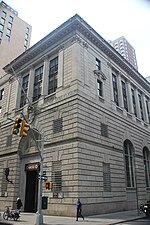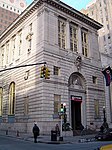Crescent Athletic Club House
1906 establishments in New York CityBasketball venues in New York CityBrooklyn HeightsBuildings and structures completed in 1906Buildings and structures in Brooklyn ... and 3 more
Frank Freeman buildingsSwimming venues in New York CityUse mdy dates from October 2019

The Crescent Athletic Club House is a building at 129 Pierrepont Street at the corner of Clinton Street in Brooklyn Heights, Brooklyn, New York City. Designed by prominent Brooklyn-based architect Frank Freeman and completed in 1906, the building is known today as the Bosworth Building of Saint Ann's School.
Excerpt from the Wikipedia article Crescent Athletic Club House (License: CC BY-SA 3.0, Authors, Images).Crescent Athletic Club House
Clinton Street, New York Brooklyn
Geographical coordinates (GPS) Address Phone number Website Nearby Places Show on map
Geographical coordinates (GPS)
| Latitude | Longitude |
|---|---|
| N 40.6951 ° | E -73.99228 ° |
Address
Saint Ann's School (The Bosworth Building)
Clinton Street
11231 New York, Brooklyn
New York, United States
Open on Google Maps










